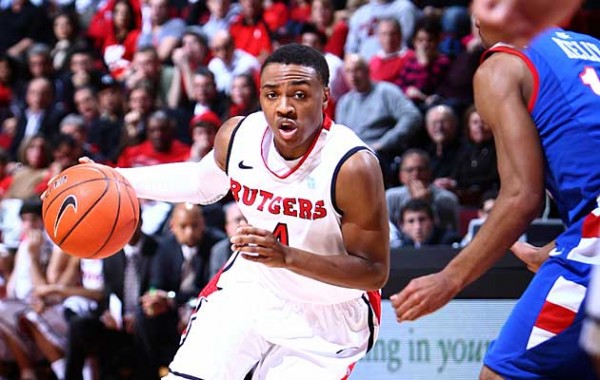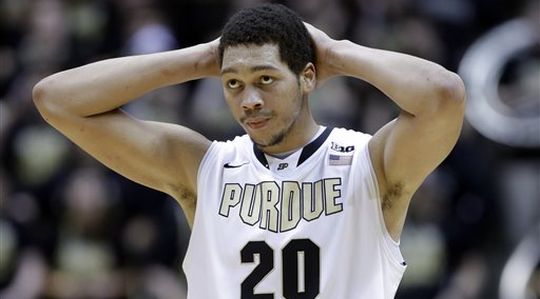RTC Big Ten Preseason Rankings: #14 to #10
Posted by Eric Clark on November 11th, 2014With college basketball’s regular season finally tipping off on Friday, the time has come for the Big Ten microsite writers to make their predictions public. We’ll begin by showcasing the five projected bottom-feeders of the Big Ten, the teams we forecast to finish from 14th to 10th.
14. Rutgers
- What they do well: There won’t be many positives for Rutgers in its inaugural Big Ten season — especially after three would-be seniors transferred during the offseason – but it looks like head coach Eddie Jordan brought in a solid recruiting class. His prized recruit is junior Bishop Daniels, a transfer from ASA College in New York City. Daniels, a former Miami player, will help solidify Rutgers’ backcourt with last year’s leading scorer, Myles Mack.
- What they don’t do well: Rebound. The Scarlet Knights only had two players average more than six rebounds per game last season (Kadeem Jack and Wally Judge), and Judge is no longer with the team. Rutgers was eighth in the AAC last season in rebounding margin, averaging 1.8 fewer rebounds per game than their opponents. Ten of the 12 Big Ten teams, on the other hand, had positive margins.
- Get to know: Kadeem Jack. Jack is Rutgers’ lone established presence in the post on an otherwise young and inexperienced roster. The 6’9″ senior grabbed almost seven rebounds per game last year and shot 50 percent from the field. He’s likely the only Big Ten-caliber forward on the team.
- Why they’ll finish 14th: Rutgers lost three senior players via transfer and has only two players, Mack and Jack, who have proven that they’re ready for Big Ten basketball. Defenses will key on those two, leaving an inexperienced cast to do – or rather, try to do – most of the heavy lifting. Eddie Jordan will overuse the phrase “growing pains” this season.
- Why they’ll finish higher: Bishop Daniels has no problem adjusting back to Division I basketball, and freshman Mike Williams establishes himself as one of the best long-range shooters in the conference. Kadeem Jack thrives down low with the outside presence of Jack, Daniels and Williams.
13. Northwestern
- What they do well: Defend – at least, better than the Wildcats used to. Head coach Chris Collins made a concerted effort to move away from the “open door policy” defense that plagued Northwestern in Bill Carmody’s final years at the helm. Collins’ team held opponents to a 41.1 percent field goal shooting last year, good enough for third in the conference.
- What they don’t do well: Score. The Wildcats ranked last in the Big Ten in scoring last season, averaging 59.5 points per game. Illinois, which ranked second-to-last, averaged almost five more points per game. The Wildcats also were last in the Big Ten in field goal percentage.
- Get to know: Vic Law. The impact of having a seasoned recruiter at head coach was felt this offseason as the Wildcats nabbed the four-star prep star away from more heralded programs like Stanford and Creighton. Law will likely crack the starting lineup at the onset of the season, and should bring a flashiness to Northwestern’s offense previously unseen by the purple faithful.
- Why they’ll finish 13th: The Wildcats are unable to replace Drew Crawford’s steady production, and JerShon Cobb fails to live up to expectations in his senior season.
- Why they’ll finish higher: Sanjay Lumpkin is able to hold down the four-spot, pairing with Alex Olah as a formidable duo in the frontcourt. Vic Law makes an immediate impact at the three, taking pressure off of JerShon Cobb to handle the scoring load.
12. Penn State
- What they do well: The Nittany Lions get to the free throw line and convert at a better-than-average clip. Penn State ranked 26th in the nation in free throw efficiency last year, with D.J. Newbill shooting 75.3 percent from the charity stripe.
- What they don’t do well: Defend the perimeter. Penn State allowed its opponents to convert on 35.2 percent of their three-pointers, the worst such mark of any Big Ten team. More pressure will be on this group to improve its perimeter defense, especially with the loss of guard Tim Frazier to graduation.

DJ Newbill has to take on more responsibility for Penn State with the loss of Tim Frazier. (GoPSUsports.com)
- Get to know: Devin Foster. Foster is a junior college transfer who should allow Newbill, Penn State’s driving force, to shift away from the point guard position and attack from the wing. Foster averaged 12.2 points and 4.8 assists per game last season at Vincennes University.
- Why they’ll finish 12th: Despite D.J. Newbill’s obvious standing as one of the premier scorers in the conference, the Nittany Lions struggle to find consistency in the frontcourt to supplement his output.
- Why they’ll finish higher: The Nittany Lions are able to cash in on Newbill’s ability to drive and dish, improving upon their poor 31.9 percent from three-point range last season. Consistency is established in the frontcourt by Donovan Jack and shot-blocker Jordan Dickerson, and Penn State’s defense helps win close games that last year’s team would have lost.
11. Indiana
- What they do well: Crash the boards. The Hoosiers were 20th in the nation in rebounds per game last year. While the loss of Noah Vonleh will certainly hurt, Indiana’s roster has plenty of tall, strong players who can control the glass.
- What they don’t do well: Make smart decisions, on and off the court. Head coach Tom Crean criticized his team for a lack of maturity last season, and the problems didn’t stop there. Numerous incidents during the offseason have significantly lowered the Hoosiers’ expectations this season, and may have prepped Crean’s job for the chopping block.
- Get to know: James Blackmon Jr. The freshman from Fort Wayne, Indiana, has dazzled in exhibition contests with high-flying dunks and a silky smooth jumper. He’ll complement Yogi Ferrell in the backcourt and will thrive if Ferrell can improve his passing skills.
- Why they’ll finish 11th: Hanna Mosquera-Perea is unable to fill the substantial void left by Vonleh, and Indiana’s interior play on both ends suffers.
- Why they’ll finish higher: The Hoosiers are able to put aside their nightmare offseason and the guard play from Ferrell, Blackmon and Robinson takes the pressure off of Mosquera-Perea inside.
10. Purdue
- What they do well: Rebound. The Boilermakers will have to rely heavily on junior center A.J. Hammons this year, a risky proposition given his less-than-stellar reputation in terms of effort.
- What they don’t do well: This could be a multitude of things, as the lineup we will see from Purdue this year will possess little experience and fanfare. Gone are Ronnie and Terone Johnson, opening up two of the starting guard positions on the roster. Kendall Stephens and Bryson Scott will have to step up their scoring, as they both will move into backcourt leadership roles.
- Get to know: Jon Octeus. Octeus was a late addition for the Boilermakers, as the 6’4 transfer from Colorado State took advantage of the NCAA’s graduate transfer rule. He averaged 13.4 points per game last season for the Rams, and brings an invaluable level of experience to an otherwise green Purdue roster.
- Why they’ll finish 10th: The Boilermakers are unable to surround Hammons with solid perimeter play, allowing defenses to consistently double-team and pester the 7-footer.
- Why they’ll finish higher: The Boilermakers receive consistent perimeter play from Stephens and Octeus, and Hammons grabs rebounds at a better clip than his 7.4 rebound-per-game average from a year ago.











































